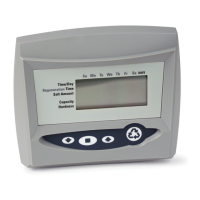31
Regeneration Modes for Parallel Systems
Parameter P16 is used to determine the method for
demand initiated regeneration. Four regeneration
modes are possible.
• P16 = 0, Delayed Regeneration with a Smart
Reserve Regenerations will start only at the Time of
Regeneration entered in P2. A tank is regenerated
if the capacity remaining in that tank is below the
minimum required capacity needed to meet the next
days calculated water usage requirement. The next
days water usage number is based on the daily
average water usage held in memory plus a 20%
reserve. If necessary both tanks will be regenerated
sequentially beginning with the most exhausted
tank.
This option allows the control to vary the reserve,
and therefore the decision to regenerate, based on
the actual daily water usage pattern for the location
at which it is installed. See Table-7.
• P16 = 1, Delayed Regeneration with a Fixed
Reserve Regenerations will start only at the Time of
Regeneration entered in P2. A tank is regenerated
if the capacity remaining in that tank is below the
percentage entered in P17.
If either tank’s capacity is overrun by 50% a
regeneration will take place. The control will also
cause both tanks to be regenerated sequentially the
next Time of Regeneration regardless of how much
water is used during that 24 hour period. This
feature is to help recover a severely exhausted bed.
See Table-8.
• P16 = 2, Immediate Regeneration - Fixed
Reserve/Delayed Re generation - Smart Re se rve
This option uses the features of both option 0 and
option 3. This is the most versatile of regeneration
options. Option number 2 provides all the
advantages of variable reserve based on the actual
amount of water that is used each day plus the
capability to react to the excessive water usage
days that occur occasionally. See Table-9.
• P16 = 3, Immediate Regeneration - Fixed Reserve
Regenerations are started immediately when a tank
reaches zero or when the system capacity
remaining (capacity remaining in both tanks) drops
below the reserve capacity programmed in P17. To
prevent hard water this reserve should be set large
enough to provide conditioned water during the
regeneration of the most exhausted tank. See
Table-10.
Table 7 TP16 = 0
Table 8 P16 = 1
Table 9 P16 = 2
Table 10P16 = 3
Priority
Flow
Rate
Continuous
Soft Water
Efficiency
High
•
Ave
••
Low
Priority
Flow
Rate
Continuous
Soft Water
Efficiency
High
•
Ave
•
Low
•
Priority
Flow
Rate
Continuous
Soft Water
Efficiency
High
•
Ave
••
Low
Priority
Flow
Rate
Continuous
Soft Water
Efficiency
High
••
Ave
Low
•

